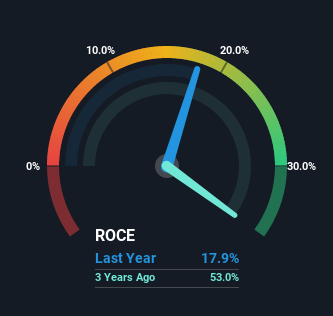
If we want to find a stock that could multiply over the long term, what are the underlying trends we should look for? One common approach is to try and find a company with returns on capital employed (ROCE) that are increasing, in conjunction with a growing amount of capital employed. If you see this, it typically means it's a company with a great business model and plenty of profitable reinvestment opportunities. In light of that, when we looked at Allied Farmers (NZSE:ALF) and its ROCE trend, we weren't exactly thrilled.
Return On Capital Employed (ROCE): What is it?
If you haven't worked with ROCE before, it measures the 'return' (pre-tax profit) a company generates from capital employed in its business. The formula for this calculation on Allied Farmers is:
Return on Capital Employed = Earnings Before Interest and Tax (EBIT) ÷ (Total Assets - Current Liabilities)
0.18 = NZ$3.1m ÷ (NZ$27m - NZ$10m) (Based on the trailing twelve months to December 2021).
So, Allied Farmers has an ROCE of 18%. In absolute terms, that's a satisfactory return, but compared to the Food industry average of 7.0% it's much better.
Check out our latest analysis for Allied Farmers

Historical performance is a great place to start when researching a stock so above you can see the gauge for Allied Farmers' ROCE against it's prior returns. If you'd like to look at how Allied Farmers has performed in the past in other metrics, you can view this free graph of past earnings, revenue and cash flow.
So How Is Allied Farmers' ROCE Trending?
On the surface, the trend of ROCE at Allied Farmers doesn't inspire confidence. Over the last five years, returns on capital have decreased to 18% from 53% five years ago. Although, given both revenue and the amount of assets employed in the business have increased, it could suggest the company is investing in growth, and the extra capital has led to a short-term reduction in ROCE. And if the increased capital generates additional returns, the business, and thus shareholders, will benefit in the long run.
On a related note, Allied Farmers has decreased its current liabilities to 37% of total assets. That could partly explain why the ROCE has dropped. Effectively this means their suppliers or short-term creditors are funding less of the business, which reduces some elements of risk. Since the business is basically funding more of its operations with it's own money, you could argue this has made the business less efficient at generating ROCE.
The Bottom Line On Allied Farmers' ROCE
In summary, despite lower returns in the short term, we're encouraged to see that Allied Farmers is reinvesting for growth and has higher sales as a result. Furthermore the stock has climbed 46% over the last five years, it would appear that investors are upbeat about the future. So should these growth trends continue, we'd be optimistic on the stock going forward.
On a separate note, we've found 1 warning sign for Allied Farmers you'll probably want to know about.
While Allied Farmers may not currently earn the highest returns, we've compiled a list of companies that currently earn more than 25% return on equity. Check out this free list here.
New: Manage All Your Stock Portfolios in One Place
We've created the ultimate portfolio companion for stock investors, and it's free.
• Connect an unlimited number of Portfolios and see your total in one currency
• Be alerted to new Warning Signs or Risks via email or mobile
• Track the Fair Value of your stocks
Have feedback on this article? Concerned about the content? Get in touch with us directly. Alternatively, email editorial-team (at) simplywallst.com.
This article by Simply Wall St is general in nature. We provide commentary based on historical data and analyst forecasts only using an unbiased methodology and our articles are not intended to be financial advice. It does not constitute a recommendation to buy or sell any stock, and does not take account of your objectives, or your financial situation. We aim to bring you long-term focused analysis driven by fundamental data. Note that our analysis may not factor in the latest price-sensitive company announcements or qualitative material. Simply Wall St has no position in any stocks mentioned.
About NZSE:ALF
Flawless balance sheet with solid track record.


